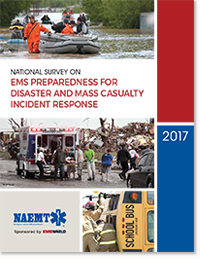
To understand the perceptions of Emergency Medical Services (EMS) personnel on their level of readiness to respond to large disasters and mass casualty situations, NAEMT conducted a national survey of EMS practitioners and managers in 2016. The findings from that survey have now been published. The NAEMT
National Survey on EMS Preparedness for Disaster and Mass Casualty Incident Response provides insight into the level of proficiency and training of EMS practitioners to provide the medical response expected by communities during disasters and mass casualty incidents.
Download Report
The survey results found that the majority of EMS practitioners had some training in preparing to respond to major incidents, and most considered themselves proficient on response protocols. Yet the survey also revealed significant gaps in EMS preparedness for response to natural and man-made disasters and mass casualty incidents. Education and training – key components of preparedness – are often sporadic, making it difficult to keep skills and knowledge fresh. While there were some areas of strength (such as responding to active shooter incidents), there were other areas that few EMS practitioners had received any training, such as chemical, biological or radiological events, and pandemics.
The biggest obstacle to EMS preparedness, according to the survey, is the cost – 75% of respondents cited lack of funding as a barrier. EMS lacks a dedicated federal funding stream to help support the training, equipment and planning needed to prepare and protect the public, as well as to safeguard its own workforce.
“The role of EMS in responding to the needs of our patients, communities and nation cannot be overstated and must be embraced as an integral safeguard for our country,” said Dennis Rowe, NAEMT President. “EMS is highly mobile, capable of rapid response, and an essential component of preparedness and public health. EMS will be called to the front lines of response as it was for the Boston Marathon bombing, Ebola outbreak, Hurricane Sandy, and the San Bernardino shooting. It is in the best interest of our nation and our citizens to have EMS prepared at the level they are expected to perform.”
To strengthen EMS preparedness, the NAEMT Board of Directors adopted a position statement calling for additional training for EMS practitioners and the establishment of Ambulance Strike Teams (AST) and Emergency Medical Task Forces (EMTF) within state and regional EMS systems and large EMS agencies.